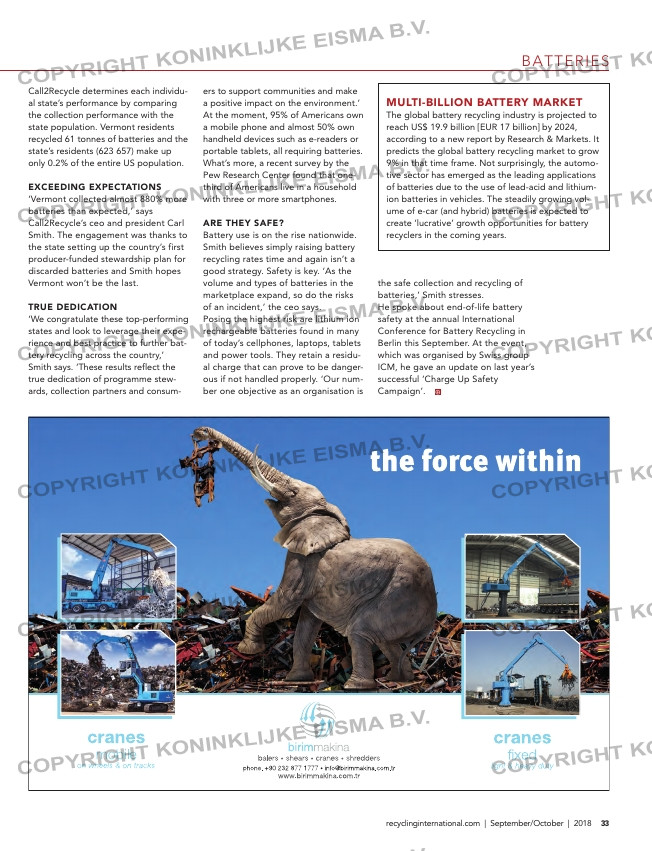Page 33 from: Autumn issue 2018

Batteries
More than 3600 tonnes of batteries were collected for recycling in
the US last year, the leading battery recycling programme
Call2Recycle has reported. Vermont was the best state based on
population and the others in the top 10 for 2017 were Delaware,
Tennessee, Minnesota, New Hampshire, California, Pennsylvania,
Washington, Maryland and Texas.
33recyclinginternational.com | September/October | 2018
Multi-billion battery Market
The global battery recycling industry is projected to
reach US$ 19.9 billion [EUR 17 billion] by 2024,
according to a new report by Research & Markets. It
predicts the global battery recycling market to grow
9% in that time frame. Not surprisingly, the automo-
tive sector has emerged as the leading applications
of batteries due to the use of lead-acid and lithium-
ion batteries in vehicles. The steadily growing vol-
ume of e-car (and hybrid) batteries is expected to
create ‘lucrative’ growth opportunities for battery
recyclers in the coming years.
Call2Recycle determines each individu-
al state’s performance by comparing
the collection performance with the
state population. Vermont residents
recycled 61 tonnes of batteries and the
state’s residents (623 657) make up
only 0.2% of the entire US population.
exceeding expectations
‘Vermont collected almost 880% more
batteries than expected,’ says
Call2Recycle’s ceo and president Carl
Smith. The engagement was thanks to
the state setting up the country’s first
producer-funded stewardship plan for
discarded batteries and Smith hopes
Vermont won’t be the last.
true dedication
‘We congratulate these top-performing
states and look to leverage their expe-
rience and best practice to further bat-
tery recycling across the country,’
Smith says. ‘These results reflect the
true dedication of programme stew-
ards, collection partners and consum-
ers to support communities and make
a positive impact on the environment.’
At the moment, 95% of Americans own
a mobile phone and almost 50% own
handheld devices such as e-readers or
portable tablets, all requiring batteries.
What’s more, a recent survey by the
Pew Research Center found that one-
third of Americans live in a household
with three or more smartphones.
are they safe?
Battery use is on the rise nationwide.
Smith believes simply raising battery
recycling rates time and again isn’t a
good strategy. Safety is key. ‘As the
volume and types of batteries in the
marketplace expand, so do the risks
of an incident,’ the ceo says.
Posing the highest risk are lithium ion
rechargeable batteries found in many
of today’s cellphones, laptops, tablets
and power tools. They retain a residu-
al charge that can prove to be danger-
ous if not handled properly. ‘Our num-
ber one objective as an organisation is
the safe collection and recycling of
batteries,’ Smith stresses.
He spoke about end-of-life battery
safety at the annual International
Conference for Battery Recycling in
Berlin this September. At the event,
which was organised by Swiss group
ICM, he gave an update on last year’s
successful ‘Charge Up Safety
Campaign’.
32-33_batteryconferencepreview.indd 33 20-09-18 14:19



